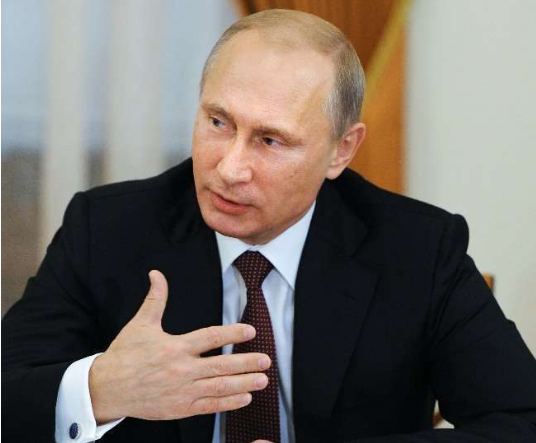Putin’s threat is being taken to mean that he is following a strategy of increasing the fight to end the war. This is the biggest challenge to the rule-based system and the foundation of the United Nations Charter standing on the principle of national sovereignty and integrity.
Shivkant Sharma. Explosions this week in the Russian province of Transnistia, bordering Moldova and Ukraine, and in the armory of the Russian city of Belgorod, bordering Ukraine’s northern border. It is estimated that these explosions were caused by missiles of the Ukrainian army. Ukraine did not confirm the speculation, but Putin made a furious threat, saying, “Any third country that interferes in the war and poses a strategic threat to us will be given a lightning-like response.” He clarified his threat. While saying that we have such weapons, which no one else can claim to have and if need be, we will not hesitate to use them. Putin’s threat has created panic in the corridors of harmony and diplomacy.
Samarniti experts believe that Putin is upset by the lack of expected success on any front of the Ukrainian war. His threat is being taken to mean that he is following a strategy of increasing the fight to end the fight. If NATO countries continue to supply new weapons to the Ukrainian military, they may go to the extent of using tactical nuclear weapons that have a limited range. Along with the lengthening of the war, two reasons are being given for the increasing nuclear threats.
One, the Russian army is not getting the success it expected. Second, NATO countries do not stand anywhere in front of Russia in terms of nuclear weapons capable of hitting a limited range. The United States had the most powerful and most nuclear weapons until the end of the Cold War and the disintegration of the Soviet Union. He also had the most powerful and better missiles to fire them, but after the end of the Cold War the US ignored its preference, while Russia, under Putin, continued to make them. After the Budapest Treaty of 1994, Ukraine’s nuclear weapons were also received by Russia.
Nuclear weapons can be broadly classified into two categories. Long-range attackers, which are mounted on ballistic missiles. The US has 5,500 strategic nuclear weapons, while Russia currently has 6,000 strategic nuclear weapons. The real counterbalance is that of nuclear weapons with a limited range, which can be fired from a distance of 300 km. They are used to destroy enemy tanks and army’s strategy. During the Cold War, the US and the Soviet Union produced thousands of such nuclear weapons every year.
The United States destroyed most of its tactical nuclear weapons and withdrew them from NATO countries in Europe thanks to the nuclear disarmament treaties signed during and after the final years of the Cold War, but Russia retained about 2,000 of its tactical nuclear weapons. So today America has a total of two hundred tactical nuclear weapons left, while Russia has two thousand. America’s more than a hundred tactical nuclear weapons are deployed in Belgium, Germany, the Netherlands, Italy and Turkey to protect NATO countries. Russia has placed most of its tactical nuclear weapons near the borders of NATO countries. Russia’s tactical nuclear weapons can be used by many means such as ballistic missiles, cannons, torpedoes of aircraft and submarines. Whereas tactical weapons of NATO countries can only be dropped by planes. Russia’s advance in tactical nuclear weapons has worried NATO countries.
The problem with NATO countries is that their governments are democratic, where it is not possible to risk a nuclear war without public support. So even if Putin manages to use tactical nuclear weapons, it will probably not be possible for NATO to launch a nuclear attack in retaliation. Anyway, Russia’s advance in tactical nuclear weapons will require NATO to resort to long-range strategic nuclear weapons, the use of which will not prepare the people of NATO countries to take the risk of widespread destruction. Putin is engaged in the war by applying all this math.
Putin’s new aim is to create a new puppet country by adding Donbass, Odessa etc. It will act as a buffer between the rest of Ukraine and Russia. He also wants to link it with Transnistia, a Russian separatist province on the border between Moldova and Ukraine, where a Russian contingent has been stationed since 1992. Despite repeated promises to the United Nations, Russia has not removed it from there.
Putin has also opened the front of the economic war by shutting down the gas supply of Poland and Bulgaria, who do not accept the condition of payment in rubles. Due to this, not only will the Russian economy suffer, the economy of Europe can also get caught in the vortex of recession, which will not only affect Europe but the whole world. The way Putin dealt with the UN Secretary-General, it is clear that he is in no mood for any talks or ceasefire at this time. On the other hand, the hatred of Putin and Russia is deepening due to the atrocities and destruction of the Russian military in Ukraine.
The people of Ukraine are not ready to surrender and live under the threat of Russia. In such a situation, NATO has no option but to keep helping Ukraine while avoiding a direct competition with Russia. The new challenge before NATO is also the security of neutral countries like Finland and Sweden, which now want NATO membership. Putin wouldn’t mind this at all. It is a matter of concern for the United Nations that for the first time in its history, a country is forcibly dismembering an independent country by attacking it and it is not able to stop it.
